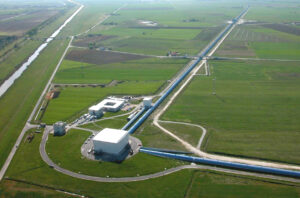The Virgo gravitational wave detector in Italy will participate in its fourth observing campaign together with the LIGO detectors in the US starting next week April 10th. The restart follows an unexpectedly long period of trouble shooting for the European detector.
Virgo is an interferometer with arms three kilometers long near Pisa that can detect minute vibrations of space and time. The installation measures how the vibrations affect the distances between mirrors using laser beams.
Such space-time vibrations arise from collisions of black holes or neutron stars in the universe. The first gravitational waves, predicted by Einstein’s theory of relativity, were observed in 2015.
Virgo is part of the international LIGO-Virgo-Kagra collaboration, with the two detectors in the U.S., the one in Pisa and an underground facility in the testing phase in Japan. Nikhef is one of the lead partners in Virgo, making important contributions to it. Nikhef is closely involved in the data analyses of the LVK observations.

After all the work, Virgo’s sensitivity is now at the highest level the detector could achieve before: 60 Mpc, an astronomical measure for the distance that the detector still senses a signal from colliding black holes.
Work on improving sensitivity will continue during the current measurement period. In doing so, Virgo will help locate the sources of gravitational waves, said Virgo spokesman Gianluca Gemme.
LIGO has a sensitivity of 140-160 Mpc and observed over eighty gravitational waves in the first half of the fourth O4a measurement period since last year. Together with Virgo, they hope to reach at least 200 event observations in the rest of O4, one detection every two or three days.
Gravitational waves represent a new window on the universe, especially when the measurements are combined with astronomical observations with telescopes and radio telescopes. With the measurements, Einstein’s theory of relativity can be tested, as well as theories about black holes and neutron stars, and the evolution of the universe itself.
The new measurement series will also investigate so-called continuous gravitational waves that can arise when neutron stars have small irregularities. It is also hoped to observe a supernova explosion for the first time. In addition, gravity waves originating from the Big Bang are being searched for.
The O4 run lasts until Februari 2025. As in previous observing rounds, observations will be made public immediately, so that astronomers can also search for signals with their own instruments, so-called multi-messenger astronomy. The observations will also be reported immediately on former Twitter platform X.